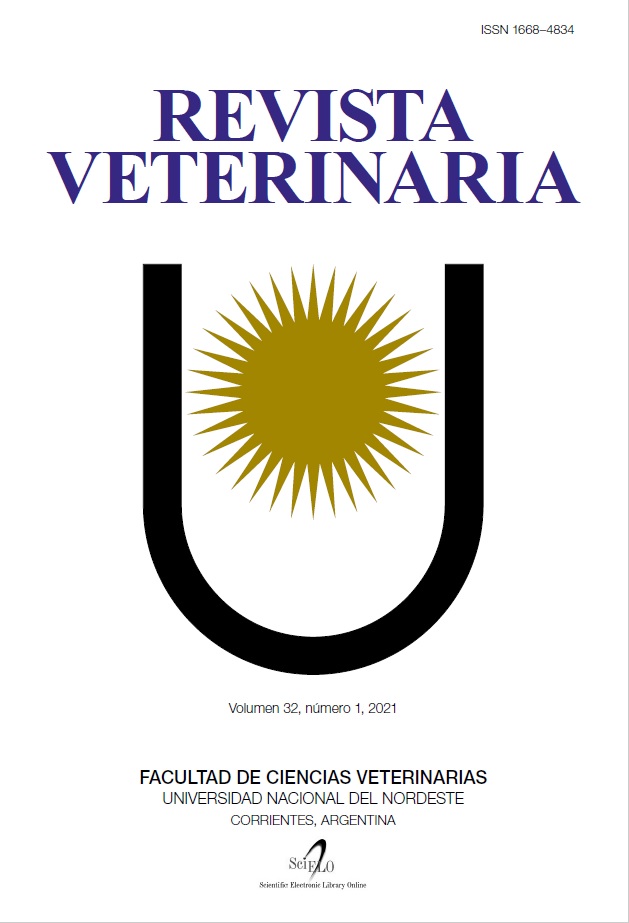Multivariate analysis of zoometric indicators of sexual maturity of breeding hens Campero INTA
DOI:
https://doi.org/10.30972/vet.3215632Keywords:
hens, development rearing, reproduction, restrictionAbstract
The aim of the present study was to evaluate the behavior of the zoometric indicators involved in the biological process of sexual maturity through multivariate analysis to explain their joint behavior and characterize their development. We worked with 400 pullets belonging to 2 genotypes (synthetic E and the hybrid ES*A) that received two nutritional levels (control and treated) between weeks 5 and 22. Canonical analysis was performed to represent the linear association of the variables obtaining equations that allow explaining a portion of the total variance of the data independent of the remaining canonical components. Four canonical components were generated from week 22 and 24. The results of the week 22 showed that the first two components explain 94.87% of the observed variation. The first component (PCC) explains 81.86% of the variance and is positively and significantly correlated with comb index (ICr) (r=0.787; p<0.0001), hip width (ACa) (r=0.626; p<0.0001), abdominal length (LAb) (r=0.527; p=0.0001) and shows no significant association with cloacal width (ACl, r=-0.072; p=0.268), correlating mainly with comb index. The second component (SCC) explains 13.01% of the variance and is positively and significantly correlated with the four variables, but to a greater extent with ACl (r=0.921; p=0.0001) and to a lesser extent with ICr (r=0.233; p=0.0003), ACa (r=0.572; p<0.0001) and LAb (r=0.515; p<0.0001). The results for week 24 for the PCC explain 70.41% of the variance and correlate in a positive and significant way with the ICr (r=0.982; p<0.0001), the ACl (r=0.615; p<0.0001), ACa (r=0.423; p<0.0001) and LAb (r=0.459; p<0.0001, doing it mainly with the comb index. The SCC explains 26.98% of the variance and correlates , in a positive and significant way with the ACl (r=0.525; p<0.0001), ACa (r=0.887; p<0.0001) and LAb (r=0.671; p<0.0001), mainly correlating with hip width and does not show an association with the ICr (r=-0.017; p=0.799). This implies that, the higher the CCP value, the birds have essentially a higher comb index, cloacal width, hip width and abdominal length It is concluded that the increase in the allocation of nutrients produces a significant increase in the average value of the canonical component, which suggests an advance of sexual maturity in both E and ES*A of greater magnitude in hybrids.
Downloads
References
Akins CH, Burns M. 2001. Visual control of sexual behavior. http://www.pigeon. psy.tufts.edu/avc/akins/-115k.
Carrasco JL, Hernán MA. 1993. Estadística multivariante en las ciencias de la vida. Ed. Ciencia 3, Madrid.
Decuypere E, Bruggeman V, Onagbesan O, Safi M. 1999. Endocrine physiology of reproduction in the female chicken: old wine in new bottles. Proceedings of the International Congress on Bird Reproduction, Tours Fr 145-153.
Joseph NS, Robinson FE, Renema RA, Thorsteinson KA. 2003. Comb growth during sexual maturation in female broiler breeders. J Appl Poult Res 12: 7-13.
McGary S, Estevez I, Bakst M. 2003. Potential relationships between physical traits and male broiler breeder fertility. Poultry Science 82: 328-337.
Mendoza AM. 2006. Nutrient utilization and reproductive performance in broiler breeder hens. A thesis submitted to the Graduate Faculty of the University of Georgia in partial fulfillment of the requirements for the degree Master of Science. University of La Salle, Colombia, 95 p.
Poole R. 1974. Sampling and the estimation of population parameters. An introduction to quantitative ecology, Ed. McGraw Hill, New York, p. 292-324.
Ramachandran R. 2014. Current and future reproductive technologies for avian species. Adv Exp Med Biol 752: 23-31.
Renema RA, Rustad ME, Robinson FE. 2007. Implications of changes to commercial broiler and broiler breeder body weight targets over the past 30 years. World’s Poultry Science Journal 63: 457- 472.
Wright D et al. 2012. Onset of sexual maturity in female chickens is genetically linked to loci associated with fecundity and a sexual ornament. Reproduction in domestic animals 47: 31-36.
Downloads
Published
How to Cite
Issue
Section
License
Revista Veterinaria (Rev. Vet.) maintains a commitment to the policies of Open Access to scientific information, as it considers that both scientific publications as well as research investigations funded by public resources should circulate freely without restrictions. Revista Veterinaria (Rev. Vet.) ratifies the Open Access model in which scientific publications are made freely available at no cost online.











.jpg)
.jpg)



